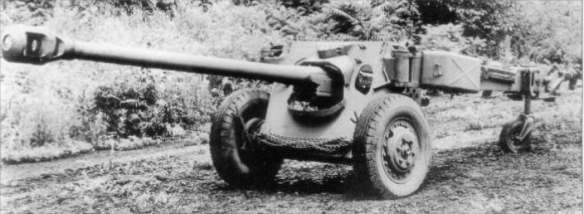An American design of anti-tank gun was this 90-mm T9. 90mm gun T13 on carriage T9. Based on a very good anti-aircraft gun, it was married to a number of carriages but eventually saw service only in self-propelled or tank mountings.
The United States also steadily continued to increase its calibers to defeat German armor. Adopted in 1938, the 37mm Gun M3 antitank gun [German 3.7cm Pak 36] was followed in 1941 by the 57mm Gun M1 [British 6pdr] and the 3-inch M5. At the same time as the 57-mm (2.24-in) was suggested, the Ordnance Department were asked to design the next generation, a gun capable of stopping any tank in the world. Their quick answer was to put together a gun by marrying-up the barrel of the 3-in (76-mm) AA gun T9, the breech ring and block of the 104-mm (4.1-in) Howitzer M2 and the carriage of the 105-mm Howitzer. This was approved as the 3-in Gun M5 in December 1941.
Originally intended as an antiaircraft design, the semiautomatic 90mm T8 Antitank Gun was adopted in 1944. Although some attempts were made to mount it on various two-wheeled split trail carriages, it saw significant combat only as either a self-propelled or tank gun. The T8 fired a 24-pound projectile to a maximum range of 21,435 yards.
Having now equipped the US Army with two foreign equipments and a home-brewed lash-up, the Ordnance Department decided that it was time to develop an American gun from the ground up, and in 1943 they began work on two projects, a 90-mm (3.5-in) gun and a 76-mm (3-in) gun. The 90-mm (3.5-in) model was based on the existing 90-mm AA gun, and by the end of 1943 two prototypes had been built. One was an orthodox split-trail carriage weapon, but this turned out to be too heavy and had to be sent back for redesign to get the weight down.
90-mm T9
The other was an unorthodox carriage in which the shield formed the basic member and the trail legs were hinged to the top corners; the legs stretched rearwards for firing and could be folded forward to lie alongside the barrel for towing. This design was worked on through 1944 and 1945 but without reaching a serviceable result, and late in 1944 the orthodox design was revived and procurement of 600 was authorized. Production was slow in starting and in August 1945 the number was cut to 200. They appeared in 1947 but were never standardized and it remained the 90-mm Gun T8 on Carriage T5E2 throughout its service.
